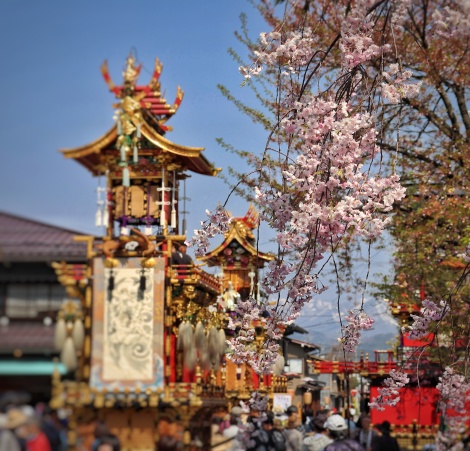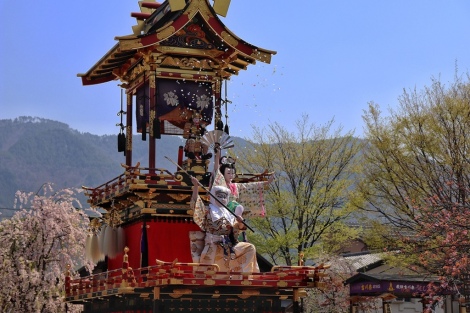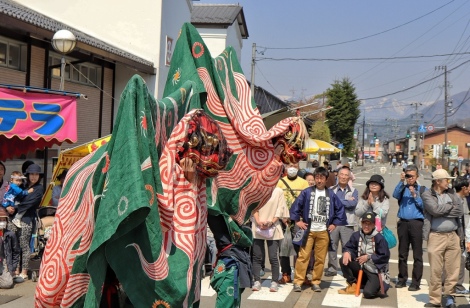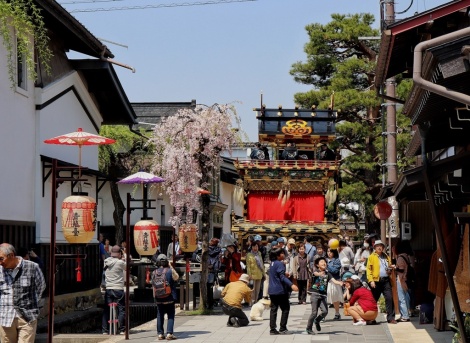Don, Don.…… Don, Don.…… Don, Don…….
The periodic pounding of the okoshi-daiko drum echoes throughout the dark, narrow streets of Furukawa-cho. The night air is filled with an intense feeling of excitement as spectators from all over have gathered to see this thrilling event that takes place just one night a year.
The Furukawa Festival is a long standing tradition that takes place every year on April 19 and 20 in Hida City. It boasts a 400 year history and was designated as an UNESCO Intangible Cultural Heritage in 2016. Festival highlights include the Okoshi-Daiko Drum Procession and the ancient yatai festival floats whose beauty and elegance showcase the exquisite craftsmanship of Hida region artisans. The Furukawa Festival can be divided into the two major themes of “movement” and “stillness” which I will explain in further detail with this special feature article.
Movement: Okoshi-Daiko Drum Procession
The Okoshi-Daiko Drum Procession can easily be considered the main event of the Furukawa Festival. It’s held on the first evening of the festival (April 19) and is meant to rouse the local residents from their winter slumber and inspire a festive spirit (okoshi-daiko in English means “drum of awakening”). The jaw-jarring beat of the okoshi-daiko and the energetic cries of festival participants can be heard all throughout the night as the procession continues on until the following morning.
The procession is actually a contest between local neighborhood districts as each participating group competes to get their tsuke-daiko, a small drum attached to the center of a long pole, as close to the giant okoshi-daiko as possible. The hundreds of shirtless men (please bear in mind that April in the mountainous Hida region remains to be very frigid) competing for the honor of their nieghborhood makes for an exciting sight as there is a lot of strategy and fighting for dominance.

Various neighborhood districts with their tsuke-daiko fight for the closest spot to the okoshi-daiko
The grid-like layout of Furukawa-cho provides an interesting setting for the contest because it offers countless strategic intersections that provide the various neighborhood groups with opportunities to ambush the okoshi-daiko and literally force their way into the fight for honor. Neighborhood groups can be seen at these key intersections waiting for the okoshi-daiko to pass by and kill time by showing off their tonbo skills. Tonbo means “dragonfly” in English and is the phrase used to describe these performances that are done to pass the time and showoff a participant’s courage. During these tonbo performances a local festival participant will climb up their district’s tsuke-daiko pole, balance at the very top with their stomach resting on the tip of the pole, and spread out their arms and legs (the tsuke-daiko are about 3m tall when stood up straight!).
At the head of the procession you will find a contingent made up of the festival participants’ family members carrying over 1,000 traditional paper lanterns. The paper lanterns (chochin in Japanese) create a beautifully mysterious atmosphere that’s so peaceful it’s almost like the calm before the storm and notifies everyone of the coming okoshi-daiko.
You will find the route of the Okoshi-Daiko Drum Procession on the official festival flyers handed out at the festival and released on Hida City social media a week or so before the festival; if you want to get up close to the okoshi-daiko you will have to stake out a spot along the route and wait there before the paper lantern contingent passes. Please note that you will most likely be pressed against surrounding people or buildings when the okoshi-daiko passes as a result of the energetic jostling of the festival participants (there are a number of police escorts to make sure they don’t get out of hand).
Stillness: Yatai Festival Floats
The second major theme of the Furukawa Festival is the stillness, or peacefulness, of the ancient yatai festival floats. Similar to the yatai of the Takayama Festival, the nine Furukawa Festival yatai are prime examples of the excellent craftsmanship of Hida region artisans. All yatai are stored and maintained by Furukawa neighborhoods and are believed to house the local god of each respective area. They have survived since the Edo period (1603~1868) and are said to be the product of combining eastern and western Japanese festival-float traditions.

The beautiful Kagura-tai which heads the yatai procession along with a contigent of traditional lion dancers
Three of the yatai have been outfitted to showcase karakuri (traditional Japanese marionette dolls) and children kabuki performances. Yatai karakuri and kabuki performances can be seen at various times of the day on April 20. The performance times change from year to year so please see the festival flyer mentioned previously for specific times.
On the 19th, yatai will be paraded around their local districts while on the 20th you can see them all gathered together in one place (the Furukawa Festival Square) during the morning and then other various locations in the afternoon. On the evening of the 20th, you can see the yatai adorned with paper lanterns creating a completely different atmosphere from what you would see during the day.
In conclusion I would recommend seeing both the okoshi-daiko and yatai in order to get the complete Furukawa Festival experience. There’s a reason that it was designated as a UNESCO Intangible Cultural Heritage and with Hida Furukawa only being a 20-minute train ride from Takayama the area is extremely easy to access. Don’t miss the opportunity to experience this long-standing Hida tradition!
Furukawa Festival Details
Date: April 19 and 20 (every year)
Venue: Furukawa Festival Square and other locations in Furukawa-cho, Hida City
Nearest Station: Hida-Furukawa (JR Takayama Line)
Access: 5-min walk from Hida-Furukawa Station
Schedule: See below for an example schedule (check Hida-Furukawa Facebook page before the festival for an updated schedule)
Notes: Nohi Bus and JR Central offer temporary event-special services between Takayama and Hida City during the festival, please check applicable websites before the festival for more info
Example Schedule (from 2018 festival)
***This 2018 schedule is just meant for general planning purposes, please see Hida-Furukawa Tourism Facebook page or official website before going to the festival for an up-to-date schedule***
Okoshi-Daiko Drum Procession
April 19
20:00-20:30 Procession Opening Ceremony (Furukawa Festival Square)
20:30-24:15 Procession (streets of Furukawa-cho)
Yatai Festival Floats*
April 19
Yatai paraded around respective districts until evening
April 20
8:00 Yatai exhibition (Furukawa Festival Square)
10:30~14:30 Yatai paraded and then exhibited at various locations in Furukawa-cho
18:00~19:30 Yatai night parade and exhibition
*Schedule may change depending on weather and will be cancelled in the case of rain
Lion Dancing, Karakuri, and Children Kabuki Performances*
April 19
8:00~16:00 Limited performances in various neighborhood districts
April 20
8:30~10:00 Round 1 of performances (at yatai exhibition location)
11:30~13:00 Round 2 of performances (at yatai exhibition location)
*In the case of rainy weather performances will be held inside respective yatai’s storehouse
This article was written based on both personal experience and official festival materials. For those who can’t make the festival in April, the Hida Furukawa Festival Museum is open all year long next to the Furukawa Festival Square. At the museum you can see a fantastic 4k English dubbed promotional video, three actual yatai, and other festival related objects that are exhibited.
Related Links
Gifu Travel Guide Website:
http://travel.kankou-gifu.jp/en/see-and-do/33/
Hida Tourism Association Website:
https://www.hida-kankou.jp/kanko/foreign/en/unesco/
Hida Tourism Association Facebook Page:
https://www.facebook.com/hidakankou/

















Fabulous event and absolutely fantastic images – the cute dog!!!
Thank you!
It’s a great festival so I hope you have the opportunity to see it in person someday.